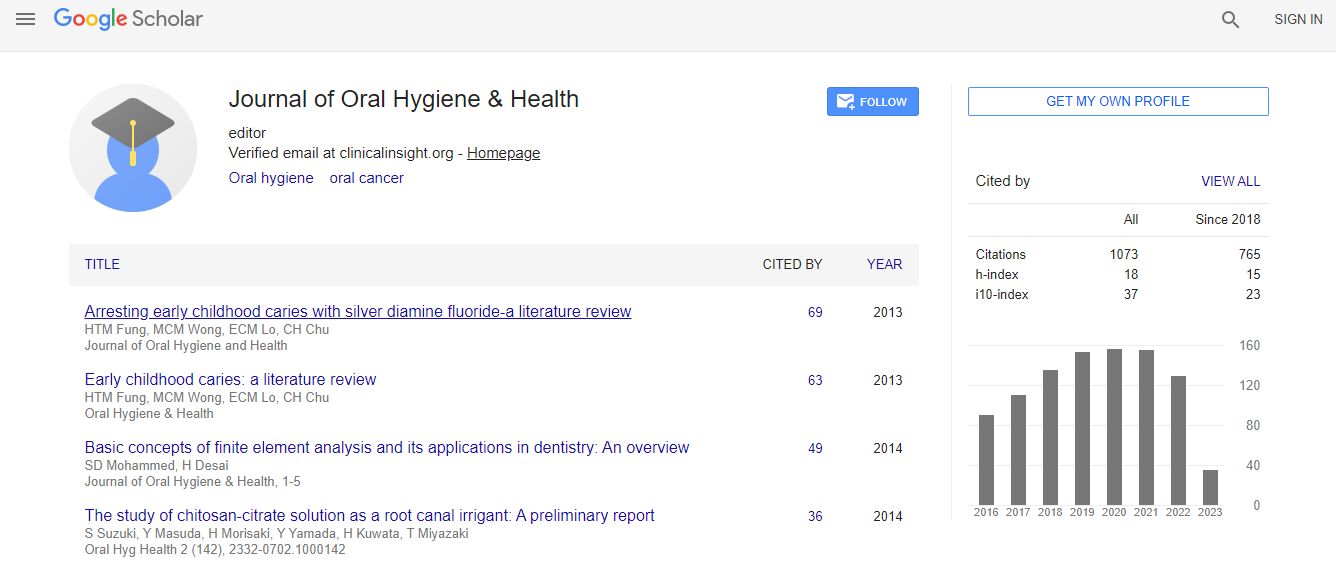Our Group organises 3000+ Global Conferenceseries Events every year across USA, Europe & Asia with support from 1000 more scientific Societies and Publishes 700+ Open Access Journals which contains over 50000 eminent personalities, reputed scientists as editorial board members.
Open Access Journals gaining more Readers and Citations
700 Journals and 15,000,000 Readers Each Journal is getting 25,000+ Readers
Google Scholar citation report
Citations : 1073
Journal of Oral Hygiene & Health received 1073 citations as per Google Scholar report
Journal of Oral Hygiene & Health peer review process verified at publons
Indexed In
- Index Copernicus
- Google Scholar
- Open J Gate
- JournalTOCs
- RefSeek
- Hamdard University
- EBSCO A-Z
- OCLC- WorldCat
- Publons
- Geneva Foundation for Medical Education and Research
- Euro Pub
- ICMJE
Useful Links
Recommended Journals
Related Subjects
Share This Page
Sealing ability of SOR flowable composite when used as an intra orifice barrier: An in vitro study
Annual Congress on Endodontics, Orthodontics, Prosthodontics and Dental Implants
Meera Acharya
Guangxi Medical University, China
ScientificTracks Abstracts: J Oral Hyg Health
Abstract
Introduction: To compare the coronal sealing ability of SOR flowable Composite with other materials (Filtek Z350 XT and GIC Fuji type II) and investigate the influence of different adhesive systems (Xeno V and Prime & Bond NT) on the sealing performance of SOR flowable Composite when used as an intra orifice barrier after root canal treatment. Methods: 54 freshly extracted human mandibular first premolar teeth with single canal were selected for the experiment and root root canal treated. After completion of RCT the teeth were divided into two groups: experimental and control. The experimental group was further divided into four sub groups as XT group, SP group, SP group and GC group and the cont 394 words group was divided into two groups as PC group and NC group. The coronal 3.5mm of gu. percha were removed from all the samples in the experimental group and and the prepared cavity is restored with the different restorative materials used in the experiment like Filtek Z350 XT, SDR flow and GIC Fuji type II. The samples in the control group is simply left as it is with gutta percha till the coronal orifice. All the samples were then incubated for one week, thermocycled in hot and cold baths simultaneously for 500 cycles and finally stained in 1% Methylene blue solution for another one week in the incubator. The samples were then split longitudinally, and the depth of dye penetration was measured under a Stereomicroscope. Results: The microleakage index of the SX group was significantly lower than the other groups while the coronal sealing ability of GC group was significantly lower than that of the other groups (P<0.05) and was not significantly different than the control group (P<0.05) Conclusion: GIC Fuji Type II can be considered unsuitable as an intra orifice barrier while SOR flowable composite in combination with Xeno V can be used as an ideal intra orifice barrier after the completion of root canal treatment.Biography
Meera Acharya is recently graduated from Guangxi Medical University, Nanning China in Conservative and Endodontics and is presently working in a private Hospital in the home town in Nepal.
E-mail: itsmeeral@yahoo.com

 Spanish
Spanish  Chinese
Chinese  Russian
Russian  German
German  French
French  Japanese
Japanese  Portuguese
Portuguese  Hindi
Hindi 
